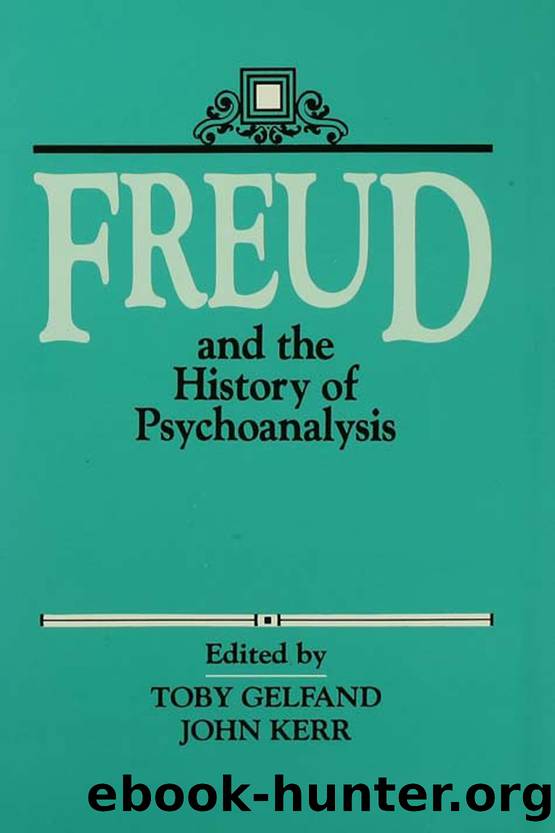Freud and the History of Psychoanalysis by Gelfand Toby;Kerr John; & Toby Gelfand & John Kerr

Author:Gelfand, Toby;Kerr, John; & Toby Gelfand & John Kerr
Language: eng
Format: epub
Publisher: Taylor & Francis Group
THE FAILURE OF DREAM REDUCTION IN LONG-TERM ANALYSANDS
My argument relies, in an essential way, on the import of Freud's theoretical assimilation of manifest dream contents to neurotic symptoms. Therefore, it is important that I be quite clear, at the outset, on the etiologic, explanatory, and investigative dimensions of that assimilation.
In the first instance, Freud postulated that manifest dream contents and neurotic symptoms are etiologically homologous by being constructed in the same manner. They are both alike compromise formations, inasmuch as the dream work, no less than neurosogenesis, features the defensive operations of repression and censorious distortion in the service of disguise: âIt will now be seen that dreams are constructed like a neurotic symptom: they are compromises between the demands of a repressed impulse and the resistance of a censoring force in the ego. Since they have a similar origin they are equally unintelligible and stand in equal need of interpretationâ (Freud, 1925, p. 45) Having assimilated the construction of dreams to the constitution of neurotic symptoms, Freud (1900) spelled out that, in regard to the role of âcausal overdetermination,â dreams are âlike all other psychopathological structuresâ (p. 149).
Freudians, no less than the rest of us, are aware of the obvious differences between the hallucinatory nature of the (visual) manifest dream scenarios and the actual displays of neurotic symptoms in the real actions of waking life. But, in the context of psychoanalytic theory, Rycroft (1973) rightly stressed their deep-seated etiologic homology: âFreud's interest in dreams derived from the fact that they are normal processes with which everyone is familiar, but which nonetheless exemplify the processes at work in the formation of neurotic symptoms (p. 37; italics added).â
In Freud's view, repressions are causally necessary for dream disguises no less than for neurosogenesis. In the case of a dream, a repressed wishful impulse âis the actual constructor of the dream: it provides the energy for its production and makes use of the day's residues as materialâ (Freud, 1925, p. 44); moreover, âa wish which is represented in a dream must be an infantile oneâ (Freud, 1900, p. 553). As for neurosogenesis, the crucial pathogen is a sexual repression of some sort. Freud drew an unclear distinction between âprimal repression,â a first phase of denying the psychical representative of an instinct entry into consciousness, and ârepression proper,â a second stage, or âafter-repression,â which banishes âmental derivatives of the repressed representativeâ (Freud, 1915, p. 148, n. 2). But there is no textual evidence for supposing that he took the respective roles of the two phases of repression to differ at all as between dream formation and symptom formation. Furthermore, as shown by the function attributed to primal fantasy in the etiology of the Wolf Man's obsessions (Freud, 1918), such fantasies cannot be claimed to be more relevant to dream production than to neurosogenesis (ch. VIII).
Indeed, Freud did stress the etiologic homology between dreams and neurotic symptoms once again, when he developed its momentous investigative corollary for the causal interpretation of dreams:
My patients were pledged
Download
This site does not store any files on its server. We only index and link to content provided by other sites. Please contact the content providers to delete copyright contents if any and email us, we'll remove relevant links or contents immediately.
Unwinding Anxiety by Judson Brewer(72055)
The Art of Coaching by Elena Aguilar(52245)
The Fast Metabolism Diet Cookbook by Haylie Pomroy(20929)
Rewire Your Anxious Brain by Catherine M. Pittman(18336)
Healthy Aging For Dummies by Brent Agin & Sharon Perkins RN(16933)
Talking to Strangers by Malcolm Gladwell(12912)
The Art of Thinking Clearly by Rolf Dobelli(9951)
Crazy Rich Asians by Kevin Kwan(8912)
Mindhunter: Inside the FBI's Elite Serial Crime Unit by John E. Douglas & Mark Olshaker(8749)
The Compound Effect by Darren Hardy(8542)
Periodization Training for Sports by Tudor Bompa(7944)
Becoming Supernatural by Dr. Joe Dispenza(7864)
Tools of Titans by Timothy Ferriss(7848)
Wonder by R. J. Palacio(7755)
Crystal Healing for Women by Mariah K. Lyons(7733)
Bodyweight Strength Training by Jay Cardiello(7686)
Therapeutic Modalities for Musculoskeletal Injuries, 4E by Craig R. Denegar & Ethan Saliba & Susan Saliba(7605)
Should I Stay or Should I Go? by Ramani Durvasula(7439)
Change Your Questions, Change Your Life by Marilee Adams(7404)
